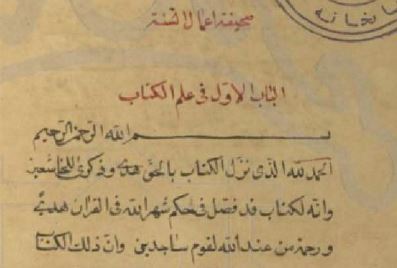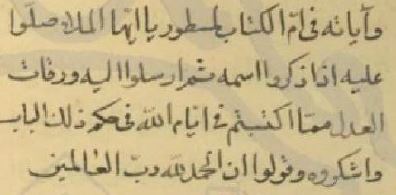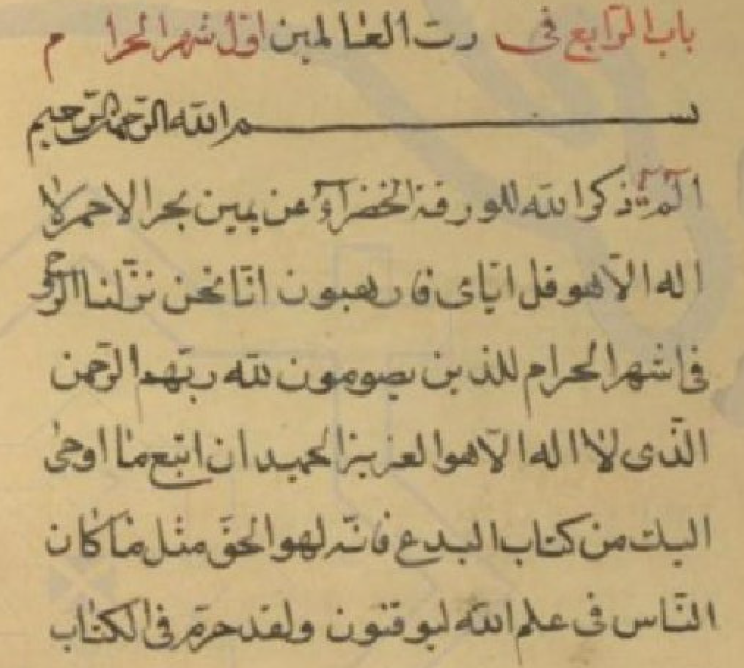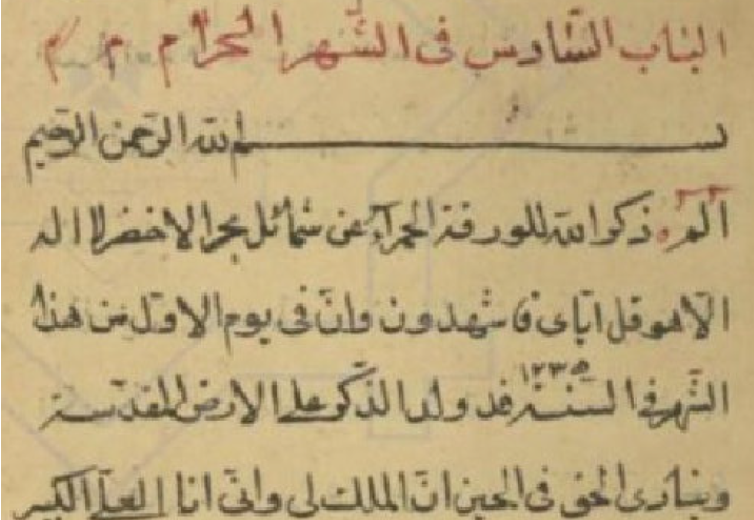
Ṣaḥīfa / Kitab a`māl al-sana
("Treatise/ Book detailing the [Religio-Devotional] Acts of the Year"). Bushire 1845 CE.
Ṣaḥīfa or Kitab a`māl al-sana

Ṣaḥīfa [Kitab] a`māl al-sana
"The Treatise [Book] on the Religio-Devotional Acts of the Year".
Bushire [Shiraz] 1261/1845 CE.
In the Khutba al-Dhikriyya the Ṣaḥīfa a`māl al-sana (the fifth of fourteen revelatory writings of the Bab) is referred to as the Ṣaḥīfa al-Fatimiyya ("The Fāṭimid Scroll-Treatise" ). It is also the fifth item listed in the Kitab al-fihrist of the Bab and thus predates it. As far as its dating MacEoin has observed in his Sources.
"Another important work written in Bushihr after the pilgrimage is the Ṣaḥīfa or Kitab `amal al-sana, which we have aIready noted as among those listed in the Kitab al-Fihrist and the Ṣaḥīfa-yi dhahabiyya [sic. = Khutba al-dhikriyya]. It is also mentioned in the Ṣaḥīfa-yi `adliyya. Evidence for the dating of this work may be found in manuscnpt 5006C in the INBA. The abbreviations (ie. 15 Jumada II 1261 /21 June 1845) are written above a line containing the phrase min hadha'l-shahr ('of this month') in the first of two sections between chapters 5 and 6 ((see contents list below). This suggests that the work was in progress at this date, only a few days before the Bab's departure from Bushihr en route for Shlrāz." MacEoin, Sources pp. 64-5)
Ṣaḥīfa a`māl al-sana
Some Notes and full Translation, Stephen Lambden 2023
In Progress - Under Revision and Completion. Last updated 25-09-2023.
At least four mss. of this text seem to be extant (cf. MacEoin, Sources, 197):
- (1). Tehran INBA 5006C pp. 262-278.
- (2). Tehran INBA 6007C pp. 413-452.
- (3) Princeton Univ. Ms.
- (4) Majlis Library Tehran ms. PDf. on this website (unpaginated).
This important Arabic work commences, according to the Majlis Lib, ms. listed above:

Ṣaḥīfa [Kitab] a`māl al-sana
al-Bab al-Awwal fi `Ilm al-Kitab
The Opening-Section on the Knowledge-Gnosis of the Book
In the Name of God, the Merciful, the Compassionate.
Praised be to God Who hath, in very truth sent down the Book, a guidance (huda) and a remembrance (dhikr an) for such as fear God. It is indeed a Book [Epistle] (kitab) which sets forth [is expository of] regulations [ritual practises] pertaining to the [successive] month(s) of God in the Qur'an. It is a guidance and a mercy on the part of God unto such persons as fall prostrate [in devotion before Him]. And this Book (dhalik al-kitab) is a directive (hukm) from the Remnant of God (Baqiyyat-Allah) an Imam of the True One ([al-] haqq), expressing clear Exposition (al-mubin),..
The Ṣaḥīfa [Kitab] A`māl al-sana concludes as follows (Majlis Library, Tehran, ms).

... O thou concourse! Express devotion before Him then be ye mindful of His Name. Then send ye unto Him the Leaves [pages] of Justice (waraqat al-`adl) of that which thou hast written during the Day of God as befits the decree of this Bab, And be ye thankful and utter the `Praised be unto God, the Lord of all the worlds'.
The Table of Contents.
With some corrections and additions MacEoin has it that the work discussed and translated here "contains fourteen chapters" or sections, "interspersed with other pieces" (see list below). Division into fourteen section is not uncommon in the writings of the Bab. To some extent it is based on the fourteen composed (14 member) Shi`i Islamic "family of God" comprising: [1] Muhammad [2] Fatimah daughter of the Prophet and wife of the first Imam `Ali ibn Abi Talib (d. 40/661) + the twelve Imams from (the aforementioned) `Ali to the 12th Imam Muhammad al-Mahdi (d. c. 260 AH/874 CE). It should be borne in mind that this Sahifa or Book deals "broadly with religious observances for various important dates through the year" and that "It bears a close resemblance to the Ṣaḥīfa makhzūna (Du`a-yi Ṣaḥīfa): of the Bab - see this website under thius title or the Sahifa Hujjatiyya.
At this point I shall revise, correct and expand MacEoin's list of contents of the Ṣaḥīfa A`mal al-Sana. I have changed MacEoin's "chapter" to Section - and added select sub-sections with occasional notes of clarification:
- I. Section One, on the Knowledge-gnosis of the Book (`ilm al-Kitab).
- II. Section Two, on the First Month of Fasting (al-siyyam) Ramadan (cf. Muḥarram)
- IIa. Section to he read after two-thirds of the night, or in mention of its end
- III. Section Three, on the first of the month of the Ḥajj (Dhu 'l-Ḥijja).
- IIIa. Section of unspecified use.
- IV. Section Four, on the first of the month of Muḥarram [Birth of the Bab]
- IVa Section, presumably to be used on the last day of Muḥarram
- IVb.Section, possibly for the same day
- V Section Five, on the month of the Ḥajj (Dhu 'l-Ḥijja).
- Va Section to he read on the day of `Arafa (9 Dhu 'l-Ḥijja), the day preceding it, the day after it, the day of Ghadīr (17 Dhu 'l-Ḥijja) every Friday, the day of bid` (?), and 24 Jumada II.
- Vb Section of unspecified use
- VI.Section Six, on the month of Muḥarram
- VIb Section of unspecified use
- VII Section Seven, on the month of Ṣafar
- VIII. Section Eight, on the month of Rabī` I
- IX. Section Nine, on the month of Rabī` II
- X. Section Ten, on the month of Jumada 1
- XI. Section Eleven, on the month of Jumada II
- XII. Section Twelve, on the eleventh of Muḥarram
- XIIa Section, to he read on every day of Jumada II (?)
- XIII Section Thirteen, on the month of Ṣafar
- XIV. Section Fourteen, on grace (faḍl)."
(Being rrvised from McEoin, Sources, 65 - adapted and expanded Lambden 2023).
♦
Ongoing Translation Stephen Lambden 2023 - last updated 29-08-2023.
![]()
Ṣaḥīfa [Kitab] A`māl al-Sana
The Epistle-Treatise on the Knowledge-Gnosis of the Devotional Acts of the [Islamo-Babi] Year.
![]()
al-bab al-awwal fi `Ilm al-kitab
The Opening-Section on the Knowledge-Gnosis of the Book
In the Name of God, the Merciful, the Compassionate.
Praised be to God Who hath, in very truth sent down the Book, a guidance (huda) and a remembrance (dhikr an) for such as fear God. It is indeed a Book [Epistle] (kitab) which sets forth, is expository of regulations [ritual practises] pertaining to the [successive] month(s) of God in the Qur'an. It is a guidance and a mercy on the part of God unto such persons as fall prostrate [in devotion before Him]. And this Book (dhalik al-kitab) is a directive (hukm) from the Remnant of God (Baqiyyat-Allah) an Imam [representing the True One [God] al-haqq)], expressing clear Exposition (al-mubin), He is the One in whose hand are the Kingdom of All-Things (malakut kull shay'). No single thing escapres His [All-Comprehensive] Knowledge (`ilm). Such as believe (al-mu'minin) in the regulation(s) of the Book (al-kitab) are truly active before Him in [religious affairs].
Say: `Be ye actively obedient unto that which hath been sent down within this Book (al-kitab) for such is indeed the Truth (al-haqq) from before God after the likeness of what We have cried out as thou hast witnessed within the Qur'an. This Book (al-kitab) is indeed a Remembrance (dhikr) on Our part, the very Pathway of God (sirat Allah) within both the heavens and upon the earth. This is indeed a Manifest Book (kitab mubin).
![]()
Section Two (al-Bab al-thani) regarding the Primary Month which is the Month of Fasting (shahr al-siyyam),
This may indicate the month of fasting as the primary ("first") month of Ramadan in which the Qur'an was sent down. Note that the Bab has section one centering on the knowledge or gnosis of the Book. This is indicated in Qur'an Q. 2:185 :
[1]
In the Name of God, the Merciful, the Compassionate.
[2]
A-L-M [Alif-Lam-Mim]
[3] The Dhikr-Allah (Remembrance of God) [speaketh forth] concerning the Month of Fasting (fi al-shahr al-siyyam) at the right-hand side of the declension of the Sun (`an yamim zawal al-shams). [4] No God is there except Him.
Say: Take heed! The Books of God (kutub Allah) bear testimony regarding the Month of Ramadan, to its marking the regulation of Fasting (hukm al-sawm). Such was indeed decreed during the Night of Power [Determination] (laylat al-qadr) [Q. 97:1f) for it is the Unprecedented Regulation (hukm al-bid`)! It is a Guidance (huda) and a Glad-Tidings (bushra) for such as are given to pious activity. God hath indeed ordained the decree of Fasting (hukm al-sawm) incorporating cessation (samat). This to the end that the people might know that thy Lord is indeed the All-Merciful (al-rahman). He is informed about that which they will actively commit during the days of God (ayyam Allah).
Say: He hath made illicit in the Book [the Qur'an] [sexual] proximity unto women (al-nisa') [wives and others during the daylight fasting period] and the stipulation(s) regarding other matters besides (al-hukm bi-ghayr an) [see Q. 2:187] ...
.
Make mention of Husayn ...
[f. 13]
hukm Allah at al-fajr (Dawn) they should mention-recollect him as one even as the Dhikr Allah Himself (nafsi-hi). Such is indeed the Pre-existent Mystery (al-sirr al-qadim) recite in it the Surat al-Ruh seventy times ...
half way through this month Hasan son of `Ali was born .... thank God for his Cause ...
This is the month in which `Ali had witnessed in the land of Kufa
Say: The greatest of all deeds during the month of Muharram is the remembrance (dhikr) of Husayn for such was revealed in the Book aforetime. And God is One Mighty, Praiseworthy!

Section Three (al-Bab al-thalith) regarding the First of the Months of Pilgrimage (ashur al-hajj),
al-bab al-thalith fi awwal ashur al-hajj
The Opening-Section on the First of the Pilgrimage Months,
[1st Dhu'l-Hijjah]
In the Name of God, the Merciful, the Compassionate.
A-L-M [Alif-Lam-Mim]
The stipulation of God regarding the Night of Fast breaking (laylat al-fitr). No God is there except Him!
Say: "Be ye thankful regarding Myself. It was after the likeness of that Night they did act in servitude after the manner of the piously humble (al-khashi`un) for He created them fearfully submissive of the Day when all shall be gathered together [for judgment] before God!
Section Four (al-Bab al-rab`) regarding the First of the Months of Muharram

[IV]
[1]
In the Name of God, the Merciful, the Compassionate!
[2]
Alif-Lam-Mim = A-L-M
[3] [From] The Dhikr-Allah (Remembrance of God) unto [nigh] the Green-Verdent Leaf (waraqat al-khudra') at the Right-Hand side of the Most Crimson Ocean (bahr al-ahmar). [4] No God is there except Him! This after the likeness of that about which the people are certain in the gnosis of God about.
[II]
[1]
Say: Before I, Myself!
Be ye piously abstemious (r-h-b) for We did indeed send down the Spirit (al-ruh) [Jesus] during the sacred month [of Muharram] unto such as performed the fast before God, their Lord, the All-Merciful. [2] He is the One who, no God is there except Him, the Mighty, the Praiseworthy. [4] So follow ye then that which was sent down (w-h-y) unto thee from the Book which is Wondrous (kitab al-badi`). [5] He is indeed the True One (al-haqq). And He hath indeed forbidden in the Book (al-kitab) ...
[X]
Say O thou concourse!
Fear ye God! And perform good works-acts of charity (al-khayrat) with justice (b'l-`adl) during the new wondrous months of al-badi` to the end that thou be among such as peform prostration.
This is the month wherein the decree of the Book alotts to the Name Husayn [Hasan] in the Preserved Tablet
Section Five (al-Bab al- ) regarding the First of the Months
Section V of the Ṣaḥīfa A`māl devoted to the first of the month of pilgrimage (ḥajj), Dhu’l-Hijjah opens (after the basmala) as follows:
“Alif-Lam-Mim. The Dhikr of God before the Crimson Leaf (waraqat al-ḥamrā’) at the Right-Hand side of the Verdent ["Life-Giving") Ocean (`an yamīn al-baḥr al-adhḍar, [crieth out] “No God is there except I Myself (anā)!”. Say: It is I Myself! So be ye prostrate! [before Me]...”
Section Six (al-Bab al- ) regarding the First of the Months

Extract from a manuscript of the Ṣāḥīfah A`māl al-Sanah f. XX Majlis Library, Tehran. ms.
“Section six pertaining to the month of Muḥarram. [M-M]
In the Name of God, the Merciful, the Compassionate
Alif-Lām-Mīm.
The Dhikr-Allāh (Remembrance of God) [the Bab] nigh [unto] the Crimson Leaf (waraqat al-ḥamrā’), at the left-hand side of the Verdent [“Life-Generating”] Ocean (shamā’il baḥr al-akhḍar). No God is there except Him.
Say: Regarding I myself!
So shall ye bear witness that it was assuredly on the first day of this month [of Muḥarram] in the year 1235 [AH, Wednesday 20th of October 1819], that the Dhikr (Remembrance [of God], the Bab) was born upon the sacred land (al-arḍ al-muqaddasa) [Shiraz as the new Mecca, Karbala]. At that very [birth] moment (al-ḥīn) he in truth cried out:
“Dominion belongeth unto Me!” (al-mulk lī).
I am indeed naught except one Exalted (`aliyy, cf. his name `Alī), Mighty (al-kabīr)!”
[1] It is difficult to know the exact sense of shamā’il (pl. sing. shimāl, 8 x in the Q,) here though it (in line with Qur’anic Arabic) where is usually indicative of the “left” or ”left-hand side” of something (Q. 7:17; 16:58, cf. Q. 18:17-18). I wonder if it might allude to the location of Shiraz as the new Mecca or Karbala (in Ottoman Iraq) to the “left” or “west” in terms of a setting Arabian-Meccan or Karbala Ḥusaynid “sun of Reality”. Alternatively, and read as shimā’il it may simply mean “good qualities” (or like like) or be indicative of a rivulet or “stream” enwrapped. In the latter connection the Arabic may have connotations of a spermatic stream or “rivulet” expressing good qualities (shimā’il) or an enwrapped embryonic “shoot” somehow conceived by the pure Fāṭimah-like mother of the Bab. She may be the one who is referred to here as the “Crimson Leaf” (waraqat al-ḥamrā’) (cf. Q. 19:24f).
[2] The Arabic here al-arḍ al-muqaddasa meaning “the holy or sacred land” was one of the ways in which the Bab referred to Mecca or Karbala. This was where Imam Ḥusayn was supposed to return or was martyred and from whence as modern day Shiraz (the new Karbala) he was born, and would thus henceforth “return”. It should also be noted here that the earlier closely parallel section II on the Fasting month of Ramadan includes a reference to
Similarly, section V of the Ṣaḥīfa A`māl devoted to the first of the month of pilgrimage (ḥajj), Dhu’l-Hijjah opens (after the basmala) as follows: “Alif-Lam-Mim. The Dhikr of God before the Crimson Leaf (waraqat al-ḥamrā’) at the Right-Hand side of the Verdent [Life-Giving) Ocean (`an yamīn al-baḥr al-adhḍar, [crieth out] “No God is there except I Myself (anā)!”. Say: It is I Myself! So be ye prostrate! [before Me]...” The use of “right-hand side” (yamīm) here points to the later “left-hand side” (translated below) being on the right lines.
Also worth noting is the fact that certain of the motifs of the opening section VI of the Ṣaḥīfa A`māl (loosely translated above) of the Bab are reflected in the family of the Bab related Sūrat al-Qarābah, “The Sūrah of the Kinsfolk”, the 28th Sūrah of the QA (XXVIII [28] trans. Lambden, H* personal website (see bib). See further the closely parallel opening of the earlier passage in Ṣaḥifa A`māl XXXX which relates al-rūḥ (the Spirit) to the “right-hand side of the to the XXXXX ,
Section Seven (al-Bab al-) regarding the First of the Months
Section Eight (al-Bab al-) regarding the
Section Nine (al-Bab al-) regarding the
Section Ten (al-Bab al-) regarding the
Section Eleven (al-Bab al-) regarding the
Section Twelve (al-Bab al-) regarding the
Section Thirteen (al-Bab al-) regarding the
Section Fourteen (al-Bab al-) regarding the
It concludes as follows (Majlis ms).

... O thou concourse! Express devotion before Him then be ye mindful of His Name. Then send ye unto Him the Leaves [pages] of Justice (waraqat al-`adl) of that which thou hast written during the Days of God regarding the Directive(s) of this Gate (fi hukm dhalik al-bab). Then render Him thanks and say, "Praised be to God, the Lord of all the worlds!"
Appendix - MacEoin's originl list in Sources:
In the Khutba al-dhikriyya this text (the fifth of fourteen items) is referred to as the Ṣaḥīfa al-Fatimiyya ("The Fāṭimid Scroll-Treatise" ). This work is the fifth item listed in the Kitab al-fihrist of the Bab and thus predates .
ADD HERE
Three or more mss. seem to be extant (see MacEoin, Sources, 197):
MacEoin, in his Sources pp. 64-5 states:
"Another important work written in Bushihr after the pilgrimage is the Ṣaḥīfa or Kitab `amal al-sana, which we have aIready noted as among those listed in the Kitab al-Fihrist and the Ṣaḥīfa-yi dhahabiyya [sic. = Khutba al-dhikriyya]. It is also mentioned in the Ṣaḥīfa-yi `adliyya. Evidence for the dating of this work may be found in manuscnpt 5006C in the INBA. The abbreviations (ie. 15 Jumada II 1261 /21 June 1845) are written above a line containing the phrase min hadha'l-shahr ('of this month') in the first of two sections between chapters 5 and 6 ((see contents list below). This suggests that the work was in progress at this date, only a few days before the Bab's departure from Bushihr en route for Shlrāz."
The book contains fourteen chapters, interspersed with other pieces, dealing broadly with religious observances for various important dates through the year. It bears a close resemblance to the Ṣaḥīfa makhzūna (Du`a-yi Ṣaḥīfa). Its contents are as follows:
The book contains fourteen chapters, interspersed with other pieces, dealing broadly with religious observances for various important dates through the year. It bears a close resemblance to the Ṣaḥīfa makhzūna (Du`a-yi Ṣaḥīfa). Its contents are as follows:
1. Chapter One, on the knowledge of the Book
2. Chapter Two, on the Fist month (i.e., Muḥarram)
3. Section to he read after two-thirds of the night, or in mention of its
end
4. Chapter Three, on the first of the month of the Ḥajj (Dhu 'l-Ḥijja)
5. Section of unspecified use
6. Chapter Four, on the first of the month of Muḥarram
7. Section, presumably to be used on the last day of Muḥarram
8. Section, possibly for the same day
9. Chapter Five, on the month of the Ḥajj (Dhu 'l-Ḥijja)
10. Section to he read on the day of `Arafa (9 Dhu 'l-Ḥijja), the day preceding it, the day after it, the day of Ghadīr (17 Dhu 'l-Ḥijja) every Friday, the day of bid` (?), and 24 Jumada II.
11. Section of unspecified use
12. Chapter Six, on the month of Muḥarram
13. Section of unspecified use
14. Chapter Seven, on the month of Ṣafar
15. Chapter Eight, on the month of Rabī` I
16. Chapter Nine, on the month of Rabī` II
17. Chapter Ten, on the month of Jumada 1
18. Chapter Eleven, on the month of Jumada II
19. Chapter Twelve, on the eleventh of Muḥarram
20. Section, to he read on every day of Jumada II (?)
21. Chapter Thirteen, on the month of Ṣafar
22. Chapter Fourteen, on grace (faḍl)." (McEoin, Sources, 65)



